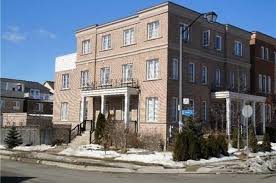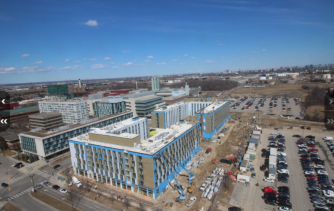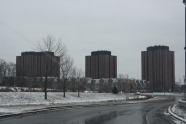Just as conditions within our homes have important implications for our health, conditions in the neighbourhoods surrounding our homes can have health effects. When examining where one lives, it’s important to look at the social and economic features that contribute to the neighbourhood, and how the physical and built environment can be detrimental to our health. Although these factors are important, it is also important to see home as a part of identity that is part of the larger community. In this written piece, I will be discussing the York University Heights neighbourhood as a mixed-income neighbourhood that represents diversity in its population. I will be examining the real estate market among the residents in neighbourhood 27, and how the village is a major characteristic of the York rental market, and how students navigate with choosing to live on campus or rent from landlords. I will also discuss how there is stigmatisation and exclusion in this neighbourhood, which will contribute to how people navigate accessing in their dwelling. Our places, our homes, our neighbourhoods, our landscapes-shapes us, and these are what contribute to health and place.
York University Heights Rental
The York University Heights neighbourhood is a demographic that consist of a high number of renters, manufacturing workers, and students that attend the local post-secondary institution York University. This area features apartment buildings, semi-detached houses, single detached houses, and townhouses. In comparison to all of Toronto, the percentage of renters are quite higher, multi-family dwellings are much higher, and dwellings requiring major repairs are a bit higher. Though this neighbourhood has a large student population, students are not the only ones who reside in this neighbourhood. According to the city of Toronto (2006), “Statistics demonstrate when comparing rented versus owned private dwellings, fifty-six percent of people rent, while forty-four percent own”. This statistic demonstrates how income determines who can afford to own their home, versus who rents. According to Mendez (2016), “ To afford such high levels of mortgage indebtedness, thousands of Vancouver homeowners have resorted to subdividing their detached dwellings through conversion of under-utilized house spaces such as basements and attics into accessory apartments”(p.2223). With the housing crisis that is taking place in the city, more and more people are renting. In this specific neighbourhood renting would be more common, considering the average price of a home is over $700,000 and the demographic is predominantly working-age (25-64), and the average income is $59,545.
THE VILLAGE
According to Munro and Livingston (2011), “All cities had very distinctly defined student areas, typically in close proximity to the main university campuses, as students want to live within a short walk to their university” (p. 1862). One of the key features a part of York University Heights is The Village. The Village is a residential neighbourhood of privately owned homes beyond the south boundary of York University Keele campus, north of Finch Avenue. York provides a shuttle bus service into the area for students who reside there. There are reports, and other news outlets stating rooming houses in this area may have up to 16 rooming units, including converted spaces in garages. This can be a major issue considering there are regulations and by-laws. According to Munro and Livingston (2011), “ This expansion of student numbers was not matched by sufficient provision of institutional accommodation by the universities; instead, students had to find their own accommodation, typically in the private rented sector (Rugg et al., 2000, 2002). Smith coined the phrase “studentification” to describe changes akin to gentrification”(p.1680). The Village was purchased from York University, by the developer Tribute communities. Creating the Village, was a strategic way to accommodate the housing need of students enrolling in the university. Creating housing for students benefits the owners because there is no regulation on surrounding how high one can charge for rent. The design of the village is based on new urbanism the features include terraces, garages opening to laneways in the back. Living in the Village for students can be very accommodating if they are looking to live near to campus and still be within walking distance and are able to afford the rent. To live in the village rent can start by $380.00 per month and upward.

ON CAMPUS
Though some students reside off campus, other students choose to live on the York University campus. Living on the University campus gives students the privilege to access many of the services such as the walk-in clinic, gym, counselling, and food services. All these services are integral to the student’s health. The cost of living on residence depends on which part of the campus one lives. Depending on which college the student resides, the price will be different for each residence. For example, students who live in Vanier, Tatham, Winters, Stong and Bethune will have to pay $6,380 for a single occupancy versus if they would share a room it would be $5,552. Living on campus and off campus for York students have their pros and cons. For example, if you live on campus it is all inclusive; students don’t have to worry about paying for utilities every month. Mandatory meal plans mean no extensive grocery shopping and can save time. The cons to living on campus are that living spaces are often cramped. The cons to living off-campus are that one can save money by finding cheap rent and groceries, can share expenses with roommates to lower costs, and apartments/houses may have more space. The downside to this, students may have additional costs, no campus security ensuring the safety of living space, and often one must find someone to sublet space during the summer.
THE QUAD-NEW CONSTRUCTION
According to Marino (2017), They’ve been busy pre-leasing apartments while working feverishly on new projects, especially those that must be completed by summer. At the same time, they are lining up additional building sites or acquisition targets to help meet rising demand for new residences in college communities across the country. Many of these dorms remain woefully outdated, devoid of the modern conveniences and privacy today’s students have come to expect. It is evident that a steady increase in University enrollment has helped stimulate the new constructions in this neighbourhood. At the corner of The Pond Road and Sentinel Road, on the south part of the York University Keele campus, there is a new high-rise building apartment that will be opening up this summer. This new luxury building is called The Quad and it comes fully furnished with scalable kitchens, high-speed Internet, a gym, lounges, modern enhanced kitchen facility. According to August (2014), “In addition, the New Urbanism promotes class-based aesthetic preferences and overlooks the potentially inequitable outcomes of design-driven redevelopment in poor neighbourhoods” (p.1162). With this new building development opening ear campus, with all the amenities and features they offer, it is clear to see how “new urbanism” in this development will distinguish itself from the other dwelling types. The rates to occupy these rooms start at $700 in a shared unit and $1,075 a month for a single occupancy room

GOVERNMENT HOUSING
On campus behind York Lanes, specifically, where the bus loop is located, you will notice a high- rise building and townhouses. Those homes and apartment buildings are Rent geared to income housing or subsidised housing. According to the United Way of Greater Toronto and The Canadian Council On Social Development (2004), “The city of Toronto Poverty intensified in five main areas. The most prominent are the Jane-Finch area, where formerly ‘high’ poverty neighbourhoods evolved into four ‘very high’ poverty areas, and were others that had ‘lower’ or ‘moderate’ levels now have ‘high’ poverty. (p. 34). Though we are focusing on York University Heights, the Jane and Finch neighbourhood is still associated with the York University neighbourhood, considering we share ward 8. Subsidised housing is a government led assistance program intended towards improving housing costs and expenses for people with low to moderate incomes. The rent is based on the tenant’s income, usually 30% of the gross monthly income. According to Pomeroy(2001), “ The three norm standards used in the core need assessment are suitability, adequacy, and affordability. Suitability determines if households have sufficient numbers of bedrooms based on the family composition. Adequacy measures housing condition to determine if the dwelling is safe has basic plumbing and is in a reasonably habitable state of repair, and Affordability is based on a ratio of housing expenditures to total household income”. A household paying more than 30 percent of its income for housing is considered in need. These three terms suitability, adequacy, and affordability are what are used to measure and determine the housing need of individuals who may need this assistance. There are many people in this neighbourhood and in the city who are living in poor conditions that do not meet these three standards for housing. According to August (2014) “ While residents may struggle to present a different image of their homes, ‘territorial stigmatisation’ has real-life impacts. Wacquant (2008:239) explains how dominant images serve to demonise public housing as a space of evil and danger, and to legitimate policy interventions that lead, for example to increased policing and surveillance, or to demolishing and redeveloping communities altogether’ (p.1164). Living in a mixed-income neighbourhood, it is evident that there can struggle to represent space. This struggle is represented by power dynamics in the neighbourhood. In the York University Heights neighbourhood, it is clear to see that the community is a socially mixed community, which means their aim is to include a mix of incomes in the same neighbourhood to have high-income and middle-income households that share the same built-up space. Though this neighbourhood is quite large, the interesting thing to note is that the social housing and homeowners are kept physically separated in the designs of the communities, either in separate buildings or on completely different streets. You can see this in the York University heights neighbourhood. For example, the social housing is located on campus, while the privately owned homes in the village are on their own street.
APARTMENT BUILDINGS AND HEALTH
The apartments in this neighbourhood are a part of Toronto’s older apartments and play’s significant aspect of the city’s housing. They characterise the rental housing in the city and is a part of affordable rentals for families. Though these dwellings are important in our neighbourhoods, many of these apartments are experiencing barriers in terms of neighbourhood liveliness and overall health and wellbeing of the residents. In this section, I will be discussing the fear of crime and stigma in the dwelling and how dwelling in apartments impact our health. According to Rollwagen (2014), “According to defensible space design principles, residents of multiunit dwellings (apartment buildings) ae more likely to experience crime because there are more communal spaces over which there is little territoriality, such as common hallways, lobbies, stairwells, and outdoor grounds. (p.367). In the York University Heights neighbourhood, according to Toronto police services this neighbourhood ranked in the top 30s for worst neighbourhoods for a break and enter robbery, and sexual assault. The statistics demonstrate how residents that reside in this neighbourhood either in an apartment or house can feel possibly unsafe. If this neighbourhood is ranked high for crime, this can contribute to residents feeling unsafe, worried, and experience anxiety. This will also contribute to how residents access their home and navigate through the community. Residents do not have control over crime, in their dwelling space. The way these buildings are built, they are opened to everyone, leaving one with little territorial space. Though crime is just one factor, the community’s health is another factor that impedes where we live. Though people reside in their own apartment, there are factors that one cannot control. For example, one does not have access to control second-hand smoke. According to Koster, Brink, and Clemmensen (2012),“Neighbour smoke in multi-unit dwellings can also originate from shared areas, such as hallways, community rooms and stairwells. Secondhand smoke can pass through leaks in walls, floors and ceilings, sharing ventilation, openings around plumbing or through poor insulation”(p.190). A tenant has no control who resides in their building, or who’s their next-door neighbour. There is a lack of autonomy for the individual who has to experience this type of risk with secondhand smoke while living in that environment. Not only does the personal environment can affect one’s health, so can the natural environment. According to Burge(2004), “The sick building syndrome (SBS) consists of a group of mucosal, skin, and general symptoms that are temporally related to working in particular buildings. It is the workers who are symptomatic, but the building or its services which are the cause. This syndrome is not only applied to workplaces but also apartment buildings where people reside”. The building environment can make people sick causing many health disparities. Biological and chemical hazards are another factor that residents in the community have no control over. Housing conditions are associated with different health conditions, including lead poisoning and mental healthThe relationship with the natural environment with many apartment neighbourhoods is subject to barriers. These are results of both their original design and changes within neighbourhoods. Tenants in low -income apartments neighbourhoods have more frequent elevator breakdowns as the source of stress, isolation and physical strain.

Lack of Shelters
This neighbourhood is a diverse neighbourhood with different ethnic groups and a different range of homes. But sometimes in neighbourhoods, not everyone is accepted and some are excluded. In the York University Heights neighbourhood, there are no shelters. Homelessness is experienced everywhere, and the fact that there is no housing shelter for those who are experiencing homelessness, that means this population is excluded from this community. According to Edwards(2003), “We don’t want you people here’ reads the headline in the Toronto Star newspaper on August 31, 2002.1 This quote from a resident expresses opposition over the prospect of a homelessness shelter moving into his neighbourhood, Iroquois Ridge in Oakville, Ontario”. There are these notions in our society that shelters are not wanted in communities because residents will fear the idea of crime and bring down property values. A community should be a community that has access to basic needs. Having a shelter in the York University Heights community is needed.

